Imagine your Instagram post going live just when most of your followers are scrolling through their feeds.
The likes start pouring in, comments pop up, and the engagement soars.
Timing is everything, and when paired with the right frequency, it can unlock massive potential for your posts.
But how do you find that sweet spot?
In this article, we’ll break down proven strategies to help you optimize both the timing and frequency of your posts for the greatest reach and engagement.

1. Understanding Your Audience’s Activity Patterns
One of the first steps to optimizing your Instagram posts is knowing when your audience is most active. Instagram’s algorithm prioritizes posts from accounts users engage with frequently, but it also factors in recency. This means that posting when your followers are online increases the likelihood that they’ll see your content in their feeds.
How to Use Instagram Insights:
- Access Instagram Insights by switching to a business or creator account.
- Go to the “Audience” tab, where you’ll see when your followers are most active.
- Pay attention to both days of the week and hours of the day. If your followers are more active in the evenings on weekdays, schedule your posts during that time.
Interactive Tip: Review your Instagram Insights weekly to see if there are any shifts in your audience’s active times. This will help you adjust your posting schedule to stay in sync with their habits.
2. The Ideal Posting Frequency: Quality vs. Quantity
Consistency is key on Instagram, but how often should you post? Posting too often might overwhelm your audience, while posting too little could make them forget about you. The goal is to strike a balance between staying visible and maintaining quality.
How Often Should You Post?
- For most accounts, 3-5 posts per week is optimal to keep your content fresh without overwhelming your audience.
- Consider Reels and Stories for more frequent interactions. You can post on Stories daily, as they disappear after 24 hours, providing a less permanent but still engaging format.
Interactive Challenge: Experiment with different posting frequencies. Try posting more often one week and less frequently the next. Track which approach leads to better engagement and adjust your strategy accordingly.
3. Test and Refine Your Timing Strategy
No two Instagram accounts are the same, and your optimal posting time may differ from others. That’s why testing different posting times and days is essential to refine your strategy.
How to Test Posting Times:
- Schedule posts at various times during the day to see when they perform best.
- Use Instagram’s native scheduling tool or a third-party app like Later or Hootsuite to organize posts in advance.
- After a month, analyze your posts’ performance using Instagram Insights. Look for trends—are morning posts getting more engagement than afternoon ones?
Pro Tip: Try posting just before your audience’s most active times. For example, if your audience is most active at 6 PM, post around 5:30 PM to be at the top of their feed when they log in.

4. Leverage Instagram’s Features to Stay Visible Between Posts
Even when you’re not posting on your feed, Instagram’s Stories, Reels, and IGTV offer additional opportunities to engage with your audience.
Use Stories for Daily Engagement:
- Post Stories daily to keep your followers engaged without overwhelming them. Stories allow for behind-the-scenes content, polls, and question stickers that invite interaction.
- Go live occasionally, as Instagram prioritizes live videos by sending notifications to your followers when you’re broadcasting.
Reels for Discoverability:
- Share Reels regularly to tap into Instagram’s push for short, engaging video content. Reels are shown not only to your followers but also to new audiences through the Explore page.
Interactive Tip: Poll your audience through Stories to ask what time they prefer seeing your content. Use this feedback to adjust your timing strategy and create more audience-aligned content.
5. Adapting to Time Zones: A Global Audience Approach
If you have followers from different parts of the world, you’ll need to consider time zones when planning your posts. Posting at a time that aligns with just one region might limit your reach.
Strategies for Managing Time Zones:
- Check your Insights to see where your followers are located. If you have a significant number of followers in different time zones, try alternating posting times.
- Consider Posting Twice a Day: Posting once in the morning and once in the evening can help you reach a broader audience across time zones. Make sure each post offers value to avoid repetition.
Pro Tip: If you’re using scheduling tools, plan your posts to go live at times when your followers in various time zones are most active.
6. Don’t Be Afraid to Adjust Based on Trends
Instagram’s algorithm and user behavior are constantly evolving. What works today might not work tomorrow, which is why staying flexible is key to maintaining engagement.
How to Stay Flexible:
- Keep an eye on new features: Instagram is always rolling out updates, such as new types of content (like Reels or Guides). Integrating new features early on can give you a visibility boost.
- Monitor Competitors: Watch how other accounts in your niche are posting. If you notice a competitor’s post time consistently outperforms yours, consider adopting a similar strategy.
Pro Tip: Regularly review your top-performing posts and compare the times and days they were posted. Use this data to fine-tune your schedule.

7. Measuring Your Success: The Role of Instagram Insights
Once you’ve tested different posting times and frequencies, it’s important to measure your success. Instagram Insights provides all the metrics you need to determine which strategies are working best.
What Metrics to Focus On:
- Reach: The number of unique users who saw your post. A good reach indicates that your timing is effective.
- Impressions: The total number of times your post was seen. Higher impressions often mean your content was shown multiple times to the same users, indicating high interest.
- Engagement Rate: The total number of interactions (likes, comments, shares) divided by the number of followers. This is one of the best indicators of whether your post timing and frequency are resonating with your audience.
Interactive Challenge: Track these metrics for a month and adjust your posting times and frequencies accordingly. Don’t be afraid to experiment with different strategies until you find the one that consistently yields the highest engagement.
Conclusion: Finding Your Perfect Balance
Optimizing your Instagram post timing and frequency is a process of trial and error.
By leveraging Instagram Insights, engaging with your audience through Stories and Reels, and staying adaptable, you can find the perfect balance that maximizes your reach and engagement.
Remember, there’s no one-size-fits-all approach. Keep testing, tweaking, and listening to your audience’s feedback to refine your strategy over time.
Whether you’re posting three times a week or twice a day, consistency paired with thoughtful timing will help you grow your Instagram presence and create meaningful connections with your audience.

Pingback: How to Integrate Affiliate Links in Instagram Stories Without Losing Engagement » Outdoor Adventure